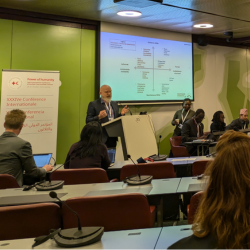-
Study
-
Quick Links
- Course Search
- Fees and Funding
- Unlock Your Potential
- Still time to Apply
- Higher and Degree Apprenticeships
- Continuing Professional Development
- Still time to apply
-
Undergraduate
- UCAS Clearing & Confirmation 2025
- Application Guides
- UCAS Exhibitions
- Foundation Years
- School & College Outreach
- Information for Parents
-
Postgraduate
- Application Guide
- Postgraduate Research Degrees
- Flexible Learning
- Change Direction
- Register your Interest
-
-
International
International
Northumbria’s global footprint touches every continent across the world, through our global partnerships across 17 institutions in 10 countries, to our 277,000 strong alumni community and 150 recruitment partners – we prepare our students for the challenges of tomorrow. Discover more about how to join Northumbria’s global family or our partnerships.
View our Global Footprint-
Quick Links
- Course Search
- Undergraduate Study
- Postgraduate Study
- Information for Parents
- London Campus
- Northumbria Pathway
- Cost of Living
- Sign up for Information
-
International Students
- Information for Students
- International Events
- Application Guide
- Entry Requirements and Education Country Agents
- Global Offices
- English Requirements
- English Language Centre
- International student support
- Cost of Living
-
International Fees and Funding
- International Undergraduate Fees
- International Undergraduate Funding
- International Masters Fees
- International Masters Funding
- International Postgraduate Research Fees
- International Postgraduate Research Funding
-
International Partners
- Agent and Representatives Network
- Global Partnerships
- Global Community
-
International Mobility
- Information for Northumbria Students
- Information for Incoming Exchange Students
-
-
Business
Business
The world is changing faster than ever before. The future is there to be won by organisations who find ways to turn today's possibilities into tomorrows competitive edge. In a connected world, collaboration can be the key to success.
More on our Business Services -
Research
Research
Northumbria is a research-rich, business-focused, professional university with a global reputation for academic quality. We conduct ground-breaking research that is responsive to the science & technology, health & well being, economic and social and arts & cultural needs for the communities
Discover more about our Research-
Quick Links
- Research Peaks of Excellence
- Academic Departments
- Research Staff
- Postgraduate Research Studentships
- Research Events
-
Research at Northumbria
- Interdisciplinary Research Themes
- Research Impact
- REF
- Partners and Collaborators
-
Support for Researchers
- Research and Innovation Services Staff
- Researcher Development and Training
- Research Ethics and Integrity
- University Library - Open Access
- Vice Chancellors Fellows
-
Research Degrees
- Postgraduate Research Overview
- Doctoral Training Partnerships and Centres
- Academic Departments
-
Research Culture
- Research Culture
- Research Culture Action Plan
- Concordats and Commitments
-
-
About Us
-
About Northumbria
- Our Strategy
- Our Staff
- Place and Partnerships
- Leadership & Governance
- Academic Departments
- University Services
- History of Northumbria
- Contact us
- Online Shop
-
-
Alumni
Alumni
Northumbria University is renowned for the calibre of its business-ready graduates. Our alumni network has over 246,000 graduates based in 178 countries worldwide in a range of sectors, our alumni are making a real impact on the world.
Our Alumni - Work For Us






 The ITGC is the largest collaboration between the UK and USA in Antarctica for 70 years. It has been granted £20 million in funding jointly by the UK Natural Environment Research Council (NERC) and the US National Science Foundation (NSF), and is taking place over a 5 year period.
The ITGC is the largest collaboration between the UK and USA in Antarctica for 70 years. It has been granted £20 million in funding jointly by the UK Natural Environment Research Council (NERC) and the US National Science Foundation (NSF), and is taking place over a 5 year period. Thwaites Glacier is located in West Antarctica, in an area known as the Amundsen Sea Embayment (ASE) on the Antarctic coastline to the south of the Pacific Ocean. It is a very important region to study, and has gathered a lot of international interest over recent years.
Thwaites Glacier is located in West Antarctica, in an area known as the Amundsen Sea Embayment (ASE) on the Antarctic coastline to the south of the Pacific Ocean. It is a very important region to study, and has gathered a lot of international interest over recent years.  A glacier is a flowing body of ice. Glaciers in Antarctica, including Thwaites, flow out into the sea just as rivers do. The technical term for this is a marine-terminating glacier. Broadly speaking, the glacier can be split into two sections: the part which is in contact with the bedrock (ice sheet) and the part which floats on the ocean (ice shelf). The boundary between these sections is known as the grounding line. Different physical processes affect these two sections of the glacier, which makes the position of the grounding line a very important factor in the dynamics of the glacier.
A glacier is a flowing body of ice. Glaciers in Antarctica, including Thwaites, flow out into the sea just as rivers do. The technical term for this is a marine-terminating glacier. Broadly speaking, the glacier can be split into two sections: the part which is in contact with the bedrock (ice sheet) and the part which floats on the ocean (ice shelf). The boundary between these sections is known as the grounding line. Different physical processes affect these two sections of the glacier, which makes the position of the grounding line a very important factor in the dynamics of the glacier. The model we use at Northumbria is called Úa. It calculates the ice velocities and thickness using a range of inputs we provide from both observational data and mathematical parameterisations representing physical processes. Before starting experiments, we set up a mesh which represents the area we are interested in. This mesh is made up of triangular elements, which gives us a lot of flexibility to control the size of elements in different parts of the domain. A calculation is performed for each mesh element, so the smaller the elements in an area the more detailed our results will be. The triangular structure also means the boundaries can be any shape we choose.
The model we use at Northumbria is called Úa. It calculates the ice velocities and thickness using a range of inputs we provide from both observational data and mathematical parameterisations representing physical processes. Before starting experiments, we set up a mesh which represents the area we are interested in. This mesh is made up of triangular elements, which gives us a lot of flexibility to control the size of elements in different parts of the domain. A calculation is performed for each mesh element, so the smaller the elements in an area the more detailed our results will be. The triangular structure also means the boundaries can be any shape we choose. A simplified sketch of the results of this procedure is shown in the figure to the right, with C0 being the initial guess, and the adapted guesses C1 and C2 producing results which get closer to the measurements. It should be noted that while this illustrates the basic concept, the inversion processes used in models are more complicated than the curve fitting illustrated here.
A simplified sketch of the results of this procedure is shown in the figure to the right, with C0 being the initial guess, and the adapted guesses C1 and C2 producing results which get closer to the measurements. It should be noted that while this illustrates the basic concept, the inversion processes used in models are more complicated than the curve fitting illustrated here.









